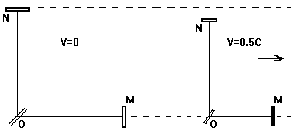Recalculation for the Michelson’s Experiment
Let us refer to a schematic picture of the interferometer.

Fig. 7. Dimensions of moving interferometer contract according to the Ivanov transformations.
Let us calculate travel time at the distance OM for a beam split by the translucent mirror, assuming that the interferometer moves with a velocity v in direction indicated by the arrow:
![]()
Doing the same for the inverse direction MO:
![]()
Before, we determined the dependence of physical dimensions upon velocity and orientation. For the arm oriented in parallel, this dependence will have a form:
![]() ,
where Lo is arm length at V = 0.
,
where Lo is arm length at V = 0.
For the arm oriented in perpendicular
![]()
Total travel time of the beam along x axis is
![]()
As we determined,
. Thus,
![]()
Now, let us perform analogous calculation for the arm ON oriented in perpendicular.
Total travel time of the ray in this direction is

It is obvious, that the performed calculation does not require any additional hypotheses and will yield zero difference between beam travel times for any velocity. This is a direct indication of the unsoundness of the idea itself to use interferometry for detection of motion in the ether.
Having arrived at a qualitatively new view of transformations of physical dimensions, having realized the accuracy of the formulas, having proved all of this with the help of geometric analysis and acoustic experiments, it was decided to find a reason, why the well known theory of relativity appeared to be incredibly hardy and effective.
In other words, if, based on the corrected classical ethereal views, we are able to demonstrate that the theory of relativity is a special case of these views and at the same time, using the method proposed by Einstein, to understand the mechanics which always leads to the same value for the light velocity, then any doubts towards the legitimacy of the ether hypothesis will be cleared up.
In this complicated but interesting problem, we will use, on one hand, previously unknown rules of wave ethero-dynamics, on the other hand, we will use the method of Einstein, which formally denies the ether.
We, certainly, have solved this problem. Now, let us see the way of solving it, so that anybody could personally verify the legitimacy of both formulations of the problem and the result obtained.
Page 10 of 26